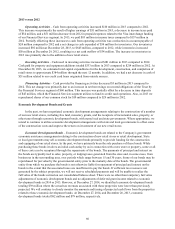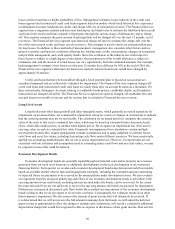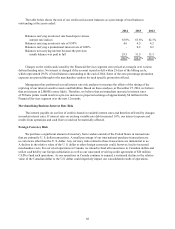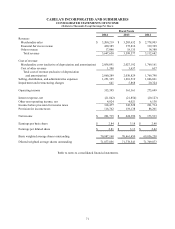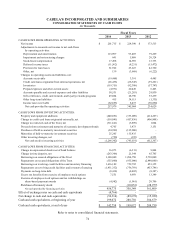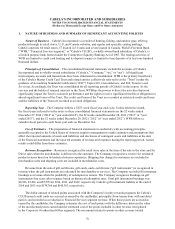Cabela's 2014 Annual Report Download - page 77
Download and view the complete annual report
Please find page 77 of the 2014 Cabela's annual report below. You can navigate through the pages in the report by either clicking on the pages listed below, or by using the keyword search tool below to find specific information within the annual report.67
value estimates been lower by 10% as of the end of 2014, the value of economic development bonds reflected in our
consolidated financial statements would have been approximately $8 million less with the unrealized loss reflected
in comprehensive income if the loss was deemed to be temporary. Any declines in the fair value of available-for-
sale economic development bonds below cost that are deemed to be other than temporary are reflected in earnings
as realized losses.
There were no other than temporary fair value adjustments of economic development bonds and
no adjustments of deferred grant income related to economic development bonds in 2014. However, at
December 27, 2014, we identified economic development bonds with carrying values of $39 million where the
actual tax revenues associated with these properties were lower than previously projected. We will continue to
closely monitor the amounts and timing of projected cash flows from the properties related to these economic
development bonds.
Income Taxes
Income taxes are estimated for each jurisdiction in which we operate and require significant judgment, the
use of estimates, and the interpretation and application of complex tax laws. Significant judgment is required in
determining the timing and amounts of deductible and taxable items, and in evaluating the ultimate resolution
of tax matters in dispute with tax authorities. Deferred tax assets and liabilities are provided for based on these
assessments. We record a liability for unrecognized tax benefits resulting from tax positions taken, or expected
to be taken, in an income tax return. We periodically reassess these probabilities and record any changes in the
consolidated financial statements as deemed appropriate. We have not provided United States income taxes on
undistributed earnings of foreign subsidiaries that we consider to be indefinitely reinvested outside of the United
States as of the end of year 2014. If these foreign earnings were to be repatriated in the future, the related United
States tax liability may be reduced by any foreign income taxes previously paid on these earnings. We have
reserved for potential adjustments to the provision for income taxes that may result from examinations by tax
authorities, and we believe that the final outcome of these examinations or agreements will not have a material
effect on our financial condition, results of operations, or cash flows.
Recent Accounting Standards and Pronouncements
Please refer to Note 2 “Accounting Pronouncements” of the Notes to Consolidated Financial Statements
included in Part II, Item 8 of this Form 10-K, which is incorporated herein by reference.
ITEM 7A. QUANTITATIVE AND QUALITATIVE DISCLOSURES ABOUT MARKET RISK
We are exposed to interest rate risk through the operations of the Financial Services segment, and, to a
lesser extent, through our merchandising operations. We also are exposed to foreign currency risk through our
merchandising operations.
Financial Services Segment Interest Rate Risk
Interest rate risk refers to changes in earnings due to interest rate changes. To the extent that interest income
collected on credit card loans and interest expense on certificates of deposit and secured obligations of the Trust do
not respond equally to changes in interest rates, or that rates do not change uniformly, earnings could be affected.
The variable rate credit card loans are indexed to the one month London Interbank Offered Rate (“LIBOR”) and
the credit card portfolio is segmented into risk-based pricing tiers each with a different interest margin. Variable
rate secured obligations of the Trust are indexed to LIBOR-based rates of interest and are periodically repriced.
Certificates of deposit and fixed rate secured obligations of the Trust are priced at the current prevailing market
rate at the time of issuance. We manage and mitigate our interest rate sensitivity through several techniques,
including managing the maturity, repricing, and mix of fixed and variable assets and liabilities by issuing fixed rate
secured obligations of the Trust or certificates of deposit and by indexing the customer rates to the same index as
the secured obligations of the Trust.





